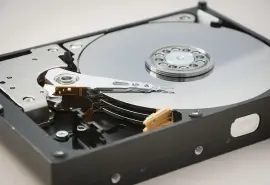Data recovery is not a one-size-fits-all industry. Today, everyone uses digital storage, from individuals preserving memories in the form of photos and videos to businesses maintaining records with sensitive data. That requires different types of data recovery services to retrieve lost files. Secure Data Recovery, the experts in RAID, SSD, and hard drive recovery, explain the differences and help you determine the service that fits your needs.
The Inevitability of Data Loss
Despite the development of storage devices over the past several decades, an inescapable fact remains: Data loss is inevitable.
All storage devices fail without exception.
The potential failures are almost endless, including human error, ransomware, power outages, and natural disasters. Regardless of the cause, data loss can happen to anyone at any time.
Fortunately, a trusted data recovery service can often extract data from a damaged device or restore permanently deleted files.
Overview: Hard Drive Recovery
Data recovery services are required when the hard disk drive (HDD) becomes damaged or the stored data is inaccessible. Recovering data begins with complicated hard drive repairs inside a state-of-the-art cleanroom to prevent further media damage. Once the HDD is returned to working condition, data recovery engineers utilize specialized hardware and software to retrieve the files.
Hard drive failure can be difficult to diagnose without a comprehensive evaluation. One of the most common data loss scenarios involves physical damage to the device. Hard drives are susceptible to damage from abrupt impacts, including dropping or mishandling the disk. They are also vulnerable when exposed to liquid, foreign substances like dust, and extreme temperatures.
However, data loss can still happen to a device that has not experienced one of these events. Sometimes hard drives fail because of logical errors. Possible issues can range from a malware infection to accidental deletion or formatting. Recovering data from a hard drive with logical errors could require advanced techniques, like file carving. The process entails technicians locating file signatures in unallocated space and reconstructing the digital data. Some cases with severe fragmentation might require additional file repair. The complexity of the case depends on the specific situation.
In the end, hard drives are mechanical devices. Their sensitive components wear down even with appropriate hard drive maintenance. In most cases, HDDs will show signs of failure before data loss occurs. Watch for these symptoms of a failing hard drive:
- Clicking, beeping, or grinding noises
- Consistent boot errors
- Frequent computer crashes or freezes
- Saving and opening files takes longer
- Overheating
- S.M.A.R.T. (Self-Monitoring, Analysis, and Reporting Technology) warnings
Noticing any of these symptoms should prompt the immediate creation of a backup to a cloud service or different storage device. Backing up valuable files can prevent or minimize sudden, catastrophic data loss.
Without regular backups, users might need specialists to recover files from a damaged or defective hard drive.
Overview: SSD Recovery
Solid-state drives (SSDs) offer a high-performance alternative to traditional HDDs in speed-drive applications. Unlike hard drives with their spinning, magnetic platters, SSDs store data in non-volatile semiconductor cells. As a result, SSDs are much faster and more efficient, accessing data in an instant and consuming less energy since data persists without a continuous power source. In addition, SSDs have integrated circuits instead of moving parts, making them a more reliable option for most users.
Although SSDs are considered more reliable than HDDs, they are not immune to data loss. First and foremost, flash memory features a limited number of write cycles. Over time, repeated write operations degrade the cells, causing their eventual failure. Once exhausted, the SSD cannot record new data.
Power fluctuations, including sudden surges, could corrupt stored data, damage the drive’s controller, and accelerate wear. In particular, SSDs are susceptible to data loss from an electrical surge while reading or writing data.
Firmware issues are another potential problem for SSDs. Like other storage media, SSDs can have programming errors and become incompatible with different devices, leading to corruption or malfunction. While firmware updates can fix the problem, the risk of data loss exists.
The controller is a crucial component that manages the SSD’s data transfers. When an SSD controller suffers catastrophic failure, it results in inaccessible data. In those cases, professional SSD recovery is required, as an engineer must bypass the controller and extract the data from the chips.
Despite their reputation for reliability, physical damage, malware attacks, and human error can still lead to data loss on an SSD. Damaging electronic components or exposing them to moisture could necessitate intricate SSD repair before recovering the missing data. The case must meet certain conditions to address an SSD’s logical errors.
The following signs tend to indicate critical degradation or imminent failure in an SSD:
- Read/write errors
- Sluggish performance
- System crashes (Blue Screen of Death)
- Drive does not appear
- Excessive bad blocks
- Overheating
- S.M.A.R.T. (Self-Monitoring, Analysis, and Reporting Technology) warnings
Regardless of the failure mode, recovering data from an SSD often requires sophisticated tools and techniques.
Overview: RAID Recovery
RAID (Redundant Array of Independent Disks) is a technology that integrates multiple drives into a logical unit to create data redundancy, enhance performance, or a combination of both. Redundancy is the practice of duplicating data within a storage environment to protect against data loss or system failure. Performance refers to improved speeds.
Different RAID levels, or logical configurations, achieve different objectives. The level refers to how data is distributed, stored, and retrieved.
RAID 0 evenly splits data across two or more drives and simultaneously accesses it. This level allows faster transfer rates when compared to a single storage device. RAID 0 focuses on providing performance benefits.
RAID 1 replicates data across two or more drives, so each device contains an identical copy of data. This configuration offers greater fault tolerance. RAID 1 does not deliver improved performance.
RAID 5 distributes data across multiple drives along with parity information. Parity information removes the need for a dedicated drive for redundancy by spreading additional data between all devices. In the event one fails, files can be reconstructed based on parity information. RAID 5 is a good balance of performance and redundancy.
RAID 6 utilizes the same techniques as RAID 5 but includes a second set of parity information, so data can be recovered even if two drives fail at the same time.
In addition, there are nested RAID levels that combine characteristics of standard configurations. For example, RAID 10 blends the mirroring technique of RAID 1 with the striping technique of RAID 0.
Users can implement RAID systems through hardware or software. Either implementation requires technical skills when it comes to recovering lost data. The best data recovery services have an extensive library of RAID controllers and tools that quickly perform XOR calculations. Each is essential to successful RAID data recovery.
Importance of Backups In Preventing Data Loss
Maintaining regular backups is the most effective approach to avoid or mitigate data loss - now and in the future. If data loss already occurred, creating a backup strategy should be part of the recovery plan.
Backup strategies vary between individuals and organizations based on their situation and requirements. Consider those factors when finalizing a strategy.
Most experts recommend the 3-2-1 Rule: Keeping three copies of data on two different storage mediums, with one stored offsite.
The best practices feature a combination of backups. Businesses and people can have an on-site backup on an external hard drive for immediate or shared access. To protect against disasters like cyberattacks, floods, and fires, individuals and organizations can also create an off-site backup, which stores data in a separate location. A cloud service can serve as a flexible, scalable storage option, duplicating data in a secure place that can be accessed on multiple devices.
Beyond that, users must determine their preferred type of backup.
Here are the most common types of backups:
- Full Backup: A backup of all data in a storage device or system. Individuals and organizations should always create a full backup initially. While full backups are the most comprehensive, they are also the most intensive.
- Incremental Backup: A backup of all additions and changes since the last backup. Incremental backups are faster than full backups and do not require as much storage space, but the restoration process is more tedious.
- Differential Backup: A backup of all additions and changes since the last full backup. Restoring differential backups is easier than incremental backups, but they often consume more storage space.
Each type of backup captures important data and can prevent data loss. Choose the backup type that most aligns with specific needs.
Finding the Right Data Recovery Service For You
For many reasons, choosing professional data recovery services is the surest method of reclaiming lost files. In most cases, it comes down to a much higher success rate than data recovery software.
However, finding the right data recovery service to retrieve your data is crucial. You need a partner that understands data loss and how to quickly reverse it.
With over 15 years of experience, at Secure Data Recovery we’ve encountered every kind of data loss or failure scenario imaginable and resolved over 100,000 cases. Anything from severe physical damage to devastating ransomware incidents. Our engineers have expertise across all storage devices, manufacturers, operating systems, and file types.
Our 96% success rate is a testament to our development of cutting-edge techniques, our investment in world-class facilities like a Class 10 ISO 4 cleanroom, and our secure process.
In addition to industry-leading expertise, we also take security seriously. Ensuring your personal or private data remains confidential is our top priority. We have implemented over 100 security controls and undergo regular audits to demonstrate the effectiveness of our systems. In fact, we have more industry-specific certifications than other data recovery services.
On top of that, we offer a free diagnostic and quote, alongside a “No Data, No Recovery Fee” guarantee. You get your data back, or pay nothing. We are available 24/7 with several options, including in-lab, on-site, remote, and emergency data recovery services.
Call us today at 800-388-1266 to start a case and find the right data recovery service for you. Don’t let sudden data loss become permanent. Trust the experts when you need it most.







